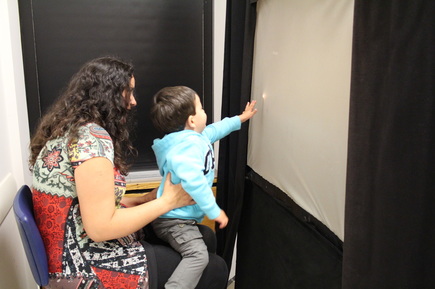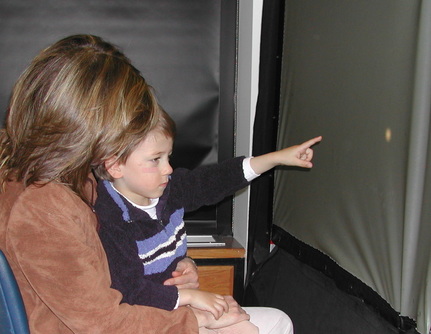Dark Adapted Threshold (DAT) Test
The dark adapted threshold test (DAT) evaluates night vision using dim spots of light in a dark room. It helps us determine the minimum light level that an infant or child can detect. With increasing time in the dark, the cells of the retina become more sensitive to light. Therefore, before testing begins, the child sits in the dark for 30 minutes to allow his/her eyes to become maximally sensitive.
Once the eyes have adapted to the darkness, the child views a black screen onto which dim spots of light are projected. The spots are projected one at a time, either to the right or to the left side of the screen, and as the test proceeds, the spots become dimmer and dimmer. Children are asked to point to the spots until they can no longer detect them. The dimmest intensity that the child can detect is his/her dark adapted threshold.
When infants are tested, an observer with a night vision camera attempts to determine the location of the spots based on the infant's head and eye movements. The infant's threshold is defined as the dimmest intensity for which the observer can reliably identify the location of the stimulus.
The entire test, including the period of dark adaptation, typically takes less than an hour.
The dark adapted threshold test (DAT) evaluates night vision using dim spots of light in a dark room. It helps us determine the minimum light level that an infant or child can detect. With increasing time in the dark, the cells of the retina become more sensitive to light. Therefore, before testing begins, the child sits in the dark for 30 minutes to allow his/her eyes to become maximally sensitive.
Once the eyes have adapted to the darkness, the child views a black screen onto which dim spots of light are projected. The spots are projected one at a time, either to the right or to the left side of the screen, and as the test proceeds, the spots become dimmer and dimmer. Children are asked to point to the spots until they can no longer detect them. The dimmest intensity that the child can detect is his/her dark adapted threshold.
When infants are tested, an observer with a night vision camera attempts to determine the location of the spots based on the infant's head and eye movements. The infant's threshold is defined as the dimmest intensity for which the observer can reliably identify the location of the stimulus.
The entire test, including the period of dark adaptation, typically takes less than an hour.

